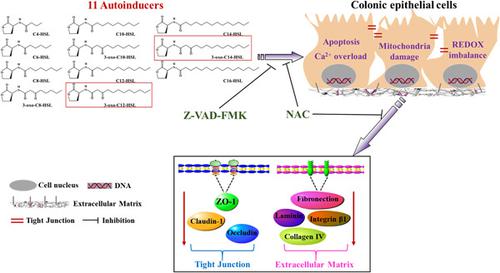当前位置:
X-MOL 学术
›
J. Cell. Physiol.
›
论文详情
Our official English website, www.x-mol.net, welcomes your
feedback! (Note: you will need to create a separate account there.)
N‐(3‐oxododecanoyl)‐l‐homoserine lactone disrupts intestinal epithelial barrier through triggering apoptosis and collapsing extracellular matrix and tight junction
Journal of Cellular Physiology ( IF 4.5 ) Pub Date : 2021-01-05 , DOI: 10.1002/jcp.30261 Shiyu Tao 1, 2 , Yi Xiong 3 , Dandan Han 1 , Yu Pi 1 , Hanlu Zhang 1 , Junjun Wang 1
Journal of Cellular Physiology ( IF 4.5 ) Pub Date : 2021-01-05 , DOI: 10.1002/jcp.30261 Shiyu Tao 1, 2 , Yi Xiong 3 , Dandan Han 1 , Yu Pi 1 , Hanlu Zhang 1 , Junjun Wang 1
Affiliation

|
Microbes employ autoinducers of quorum sensing (QS) for population communication. Although the autoinducer of Pseudomonas aeruginosa LasI‐LasR system, N‐(3‐oxododecanoyl)‐
l‐homoserine lactone (3OC12), has been reported with deleterious effects on host cells, its biological effects on integrity of the intestinal epithelium and epithelial barrier are still unclear and need further investigation. In the present study, flow cytometry, transcriptome analysis and western blot technology have been adopted to investigate the potential molecular mechanisms of 3OC12 and its structurally similar analogs damage to intestinal epithelial cells. Our results indicated that 3OC12 and 3OC14 trigger apoptosis rather than necrosis and ferroptosis in intestinal epithelial cells. RNA‐sequencing combined with bioinformatics analysis showed that 3OC12 and 3OC14 reduced the expression of genes from extracellular matrix (ECM)‐receptor interaction pathway. Consistently, protein expressions from ECM and tight junction‐associated pathway were significantly reduced after 3OC12 and 3OC14 challenge. In addition, 3OC12 and 3OC14 led to blocked cell cycle, decreased mitochondrial membrane potential, increased reactive oxygen species level and elevated Ca2+ concentration. Reversely, the antioxidant NAC could effectively mitigate the reduced expression of ECM and tight junction proteins caused by 3OC12 and 3OC14 challenge. Collectively, this study demonstrated that QS autoinducer exposure to intestinal epithelial cells ablates the ECM and tight junctions by triggering oxidative stress and apoptosis, and finally disrupts the intestinal epithelial barrier. These findings provide a rationale for defensing QS‐dependent bacterial infections and potential role of NAC for alleviating the syndrome.
中文翻译:

N-(3-oxododecanoyl)-l-高丝氨酸内酯通过触发细胞凋亡和破坏细胞外基质和紧密连接破坏肠上皮屏障
微生物采用群体感应 (QS) 的自诱导剂进行种群交流。虽然铜绿假单胞菌LasI-LasR 系统的自诱导剂N-(3-oxododecanoyl) -l高丝氨酸内酯 (3OC12) 已被报道对宿主细胞有有害影响,其对肠上皮和上皮屏障完整性的生物学影响尚不清楚,需要进一步研究。在本研究中,采用流式细胞术、转录组分析和蛋白质印迹技术来研究 3OC12 及其结构相似的类似物对肠上皮细胞损伤的潜在分子机制。我们的结果表明 3OC12 和 3OC14 触发肠上皮细胞凋亡而不是坏死和铁死亡。RNA测序结合生物信息学分析表明,3OC12和3OC14降低了细胞外基质(ECM)-受体相互作用通路基因的表达。一贯地,在 3OC12 和 3OC14 攻击后,来自 ECM 和紧密连接相关通路的蛋白质表达显着降低。此外,3OC12和3OC14导致细胞周期受阻、线粒体膜电位降低、活性氧水平增加和Ca升高2+浓度。相反,抗氧化剂 NAC 可以有效减轻由 3OC12 和 3OC14 攻击引起的 ECM 和紧密连接蛋白的表达降低。总的来说,这项研究表明 QS 自诱导剂暴露于肠上皮细胞通过触发氧化应激和细胞凋亡来消融 ECM 和紧密连接,并最终破坏肠上皮屏障。这些发现为防御 QS 依赖性细菌感染和 NAC 在缓解该综合征方面的潜在作用提供了理论依据。
更新日期:2021-01-05
中文翻译:

N-(3-oxododecanoyl)-l-高丝氨酸内酯通过触发细胞凋亡和破坏细胞外基质和紧密连接破坏肠上皮屏障
微生物采用群体感应 (QS) 的自诱导剂进行种群交流。虽然铜绿假单胞菌LasI-LasR 系统的自诱导剂N-(3-oxododecanoyl) -l高丝氨酸内酯 (3OC12) 已被报道对宿主细胞有有害影响,其对肠上皮和上皮屏障完整性的生物学影响尚不清楚,需要进一步研究。在本研究中,采用流式细胞术、转录组分析和蛋白质印迹技术来研究 3OC12 及其结构相似的类似物对肠上皮细胞损伤的潜在分子机制。我们的结果表明 3OC12 和 3OC14 触发肠上皮细胞凋亡而不是坏死和铁死亡。RNA测序结合生物信息学分析表明,3OC12和3OC14降低了细胞外基质(ECM)-受体相互作用通路基因的表达。一贯地,在 3OC12 和 3OC14 攻击后,来自 ECM 和紧密连接相关通路的蛋白质表达显着降低。此外,3OC12和3OC14导致细胞周期受阻、线粒体膜电位降低、活性氧水平增加和Ca升高2+浓度。相反,抗氧化剂 NAC 可以有效减轻由 3OC12 和 3OC14 攻击引起的 ECM 和紧密连接蛋白的表达降低。总的来说,这项研究表明 QS 自诱导剂暴露于肠上皮细胞通过触发氧化应激和细胞凋亡来消融 ECM 和紧密连接,并最终破坏肠上皮屏障。这些发现为防御 QS 依赖性细菌感染和 NAC 在缓解该综合征方面的潜在作用提供了理论依据。











































 京公网安备 11010802027423号
京公网安备 11010802027423号